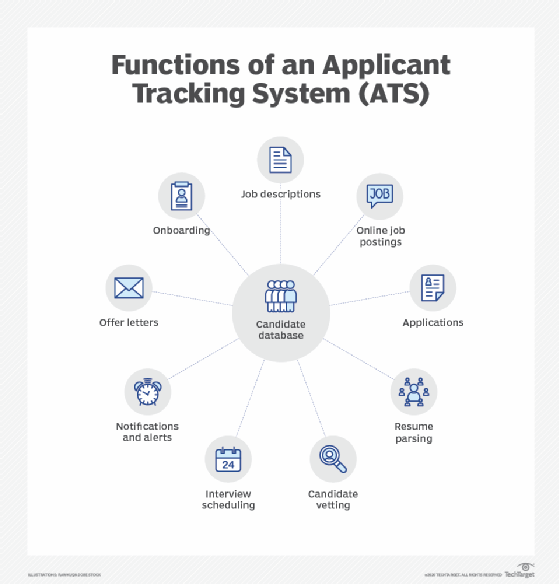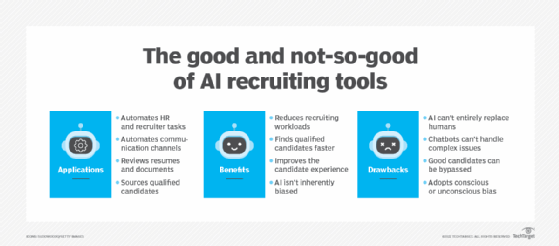e-recruitment (e-recruiting)
What is e-recruiting?
E-recruitment is an umbrella term for any electronic-based recruiting and recruitment management activity. Most human capital management software vendors don't use this term to describe their products. They call their systems recruitment software or recruiting software. The vendors have good reason to drop the e- from e-recruitment.
The origin of the term e-recruitment is similar to e-commerce. E-commerce clearly delineates online retail sales from the brick-and-mortar market. But that's not true for job advertising and recruiting because virtually all recruiting today is conducted online.
While there's still paper-based, classified job advertising, as well as job ads that appear on billboards, in subways and buses, and on signs posted in store windows, these are narrower recruitment marketing activities that often provide a company website for more information about a job. For people who walk in the door seeking work, larger retailers usually have kiosks.
Online recruitment dominates this market, and all the products in the recruiting space have some role in managing, automating, tracking and analyzing candidates and job data from online sources.
How does e-recruiting work?
E-recruitment is an informal term used to describe most recruiting that's done today. It doesn't refer to any particular aspect of the recruiting process and is used interchangeably with online recruiting, online recruitment, internet recruiting and web-based recruiting.
E-recruitment is a broad, sweeping term to introduce a discussion about recruiting systems and hiring processes. This could include recruiting management systems, social recruiting, applicant tracking systems (ATSes), recruitment marketing, candidate relationship management, talent acquisition and talent management software. These systems facilitate communication with candidates, scheduling interviews selecting the most suitable candidate and onboarding.
Social media platforms, such as Facebook and LinkedIn, are used as part of e-recruiting to post job openings and engage with potential job candidates. This interaction enhances employer branding and attracts passive job seekers. In addition, advances such as artificial intelligence (AI) are used to optimize workflows in recruitment processes, from screening resumes to scheduling interviews, making the process more efficient and faster.
Video interviewing tools are commonly used to assess candidates without having to bring them into an office setting. This approach expands the geographical reach of the recruitment process and lets employers evaluate candidates without location constraints.
E-recruitment includes technologies, such as chatbots and predictive analytics, to help identify the most qualified applicants. These systems are also being built to help root out bias, especially in job ads.

Benefits of e-recruitment
There are several benefits to e-recruitment, including the following:
- Cost efficiency. E-recruitment reduces expenses associated with traditional recruitment methods such as print advertising. Online recruitment platforms often offer lower fees, and social media recruitment provides a cost-free option for reaching potential candidates.
- Expanded reach and accessibility. Digital tools eliminate geographical boundaries, enabling access to a global talent pool. This is especially beneficial for roles requiring unique or difficult-to-find skills, because it increases the likelihood of finding the best candidates regardless of their location.
- Speed and efficiency. Automation and AI speed up the process of recruiting potential employees. AI-driven tools, such as resume screening and interview scheduling, streamline operations and facilitate quick and effective candidate evaluation.
Challenges of e-recruitment
The major challenge facing human resources (HR) managers is selecting e-recruitment systems.
Recruiting is the leading human resources management investment category. Vendor competition is intense, and the startup market is active, covering a variety of technologies, including various forms of AI and analytics. HR managers find they have many options to evaluate and difficult decisions to make. For instance, one question that might come up is whether a vendor's chatbot technology is intelligent enough to keep a potential applicant engaged. Or is a machine learning tool for finding passive candidates effective enough to risk the investment?
The biggest challenges in e-recruiting include the following:
- Overwhelming application volume. The ease of online with which candidates can submit applications with e-recruiting tools often results in a high applicant volume. Many applicants might not even be suitable for the role. This can overwhelm HR teams and make it difficult to efficiently screen and shortlist candidates to fill vacancies. HR teams must also be aware of fraudulent candidates.
- Technical issues and security concerns. Online recruitment is susceptible to technical problems, such as platform downtime, which can disrupt the recruiting process. Additionally, cybersecurity threats, such as data breaches and phishing attacks, pose risks and require security measures to protect sensitive information.
- Impersonality. E-recruitment processes can lack personal interaction and a human touch that can hinder employers' and candidates' ability to assess compatibility and cultural fit. This impersonality can prevent a thorough understanding of the candidate's capabilities beyond their resume. Organizations also must ensure they're rejecting candidates respectfully with this software.
- Competition and visibility challenges. The accessibility of online recruitment means companies face intense competition to attract top talent. This, combined with the challenge of standing out among numerous job postings, can make it difficult for companies to capture the attention of the best candidates.

Strategies for effective e-recruitment
Successfully implementing e-recruitment tools and techniques requires several strategies, such as the following:
- Designing inclusive and engaging job postings. To attract a diverse range of candidates, it's crucial to craft job descriptions that are inclusive and engaging. Organizations should use clear, concise language that includes essential requirements and highlights opportunities. They should ensure job descriptions are free from biased language and reflect a commitment to diversity, equity and inclusion.
- Using the right platforms and tools. Selecting the appropriate platforms and tools is vital for effective e-recruitment. Organizations should use online job boards, social media and professional networks to diversify their methods of sourcing talent and reach a broader audience. Advanced recruitment software can help automate the application process like resume screening and enhance the efficiency of the recruitment process.
- Balancing automation with personal engagement. Maintaining personal engagement with AI-driven recruitment methods is essential. Communication with candidates must be personalized, using their names and relevant information from their applications to improve engagement and response rates. This balance ensures a positive candidate experience and projects a positive image of the hiring organization.
- Continuous evaluation and improvement. E-recruitment strategies should be regularly assessed and refined to ensure they meet the organization's needs and adapt to changing recruitment landscapes. Organizations should use data-driven tools to monitor recruitment metrics and gather feedback from candidates to identify areas for improvement. This ongoing evaluation helps optimize recruitment processes and enhance overall effectiveness.
E-recruitment is an important method of recruiting top talent. Get up to date with the top 10 talent management software systems.







